Protection of Water Resources from Agriculture Pollution: An Integrated Methodological Approach for the Nitrates Directive 91–676-EEC Implementation
Abstract
:1. Introduction
- i.
- the identification, every four years, of the territorial areas particularly susceptible to being polluted, so-called “Nitrates Vulnerable Zones” (NVZs);
- ii.
- the preparation, within one year from the designation of the NVZs, of a set of mandatory and policy measures (Action Programs) that must be adopted by farmers, especially by those who carry out activities concerning livestock production and practices related to nitrogen fertilisation;
- iii.
- the application, by farmers, of a set of critical interventions for the correct management of agricultural activities to protect the soil and water resource, which must be referred to the Code of Good Agricultural Practice defined by the Ministry of Agriculture and Forestry Policies [12];
- iv.
- training and information initiatives aimed at agricultural operators concerning agronomic practices to protect the environment.
2. Materials and Methods
2.1. Study Area
2.2. Dataset Reconstruction
2.3. Study of the Historical Series Relating to the Concentration of Nitrates
2.4. Estimation of Intrinsic Vulnerability through Modelling Applications Aimed at the Definition of the New Perimeter of the Nitrates Vulnerable Zones
- depth to water (D), which is the depth of the aquifer (unconfined aquifer is assumed);
- average aquifer (A), or lithology of the aquifer;
- soil media (S) to indicate the type of soil;
- topography (T), which is the acclivity of the topographic surface [42];
- hydraulic conducibility (C), understood as the hydraulic conductivity of aquifers, the data of the permeability values were digitised and processed [44].
2.5. Pressures on Water Bodies Posed by Agriculture and Animal Farming
2.5.1. Estimation of the Pressures on Groundwater due to Agricultural Activity at the Municipal Level
- <0.5 = low;
- 0.5–0.8 = medium;
- >0.8 = high.
2.5.2. Estimation of the Animal Farming-Induced Pressure on Groundwater at the Municipal Level
2.6. Criterion for the Selection of Water Monitoring Points Functional to the Identification and Correct Perimeter of Nitrates Vulnerable Zones
- at least an excess of 50 mg/L in value in the last four years following an extremely precautionary approach;
- average in the last four years between 40–50 mg/L with an increasing trend;
- water monitoring points already in NVZs but for which there have been no samplings in the last four years;
- However, the points with the following criteria were not selected:
- average in the last four years between 40–50 mg/L with a stable to decreasing trend;
- average in the last four years between 25–40 mg/L with only one single measure more than 50 mg/L, stable or decreasing trend, in the previous data there is no other overcoming of the threshold;
- average in the last four years between 25–40 mg/L with only one single measure more than 50 mg/L, a trend not calculable (less than eight measures) with both low values of agricultural and livestock pressures;
- average in the last four years between <25 mg/L with only one single measure more than 50 mg/L, stable or decreasing trend;
- average in the last four years between and maximum measured value <40 mg/L;
- water monitoring points located in urban centres.
2.7. Performance of Faecal Bacteria Tracking Combined to GIS Database to Discriminate Nitrate Source
2.8. GIS Methodology for the Perimeter of Nitrates Vulnerable Zones from Agricultural Sources for Groundwater and Surface Water Bodies
3. Results
3.1. Results from the Historical Series Analysis
3.2. Results of the Application of the DRASTIC Model
3.3. Map of the Results Deriving from the Calculation of the Pressures on Water Bodies Posed by Agriculture and Animal Farming
3.4. Performances of Microbial Source Tracking Marker Assays
3.5. Final Boundary and Estimate of the Variations over the Years of the NVZs Areas
4. Discussion
5. Conclusions
Supplementary Materials
Author Contributions
Funding
Institutional Review Board Statement
Informed Consent Statement
Data Availability Statement
Acknowledgments
Conflicts of Interest
References
- Singh, K.P.; Malik, A.; Mohan, D.; Sinha, S. Multivariate statistical techniques for the evaluation of spatial and temporal variations in water quality of Gomti River (India)—A case study. Water Res. 2004, 38, 3980–3992. [Google Scholar] [CrossRef]
- FAO. IWMI Water Pollution from Agriculture: A Global Review Executive Summary; Food and Agriculture Organization of the United Nations and the International Water Management Institute: Rome, Italy, 2017; 35p. [Google Scholar]
- Carrey, R.; Ballesté, E.; Blanch, A.R.; Lucena, F.; Pons, P.; López, J.M.; Rull, M.; Solà, J.; Micola, N.; Fraile, J.; et al. Combining multi-isotopic and molecular source tracking methods to identify nitrate pollution sources in surface and groundwater. Water Res. 2021, 188, 116537. [Google Scholar] [CrossRef]
- Li, Z.; Wen, X.; Hu, C.; Li, X.; Li, S.; Zhang, X.; Hu, B. Regional simulation of nitrate leaching potential from winter wheat-summer maize rotation croplands on the North China Plain using the NLEAP-GIS model. Agric. Ecosyst. Environ. 2020, 294, 106861. [Google Scholar] [CrossRef]
- Wang, Z.H.; Li, S.X.; Wang, X.N.; Tao, S. Nitrate Nitrogen Residue and Leaching in Dryland Soil and Influence Factors. Available online: https://en.cnki.com.cn/Article_en/CJFDTotal-TURA200606001.htm (accessed on 15 December 2021).
- Zhang, X.; Davidson, E.A.; Mauzerall, D.L.; Searchinger, T.D.; Dumas, P.; Shen, Y. Managing nitrogen for sustainable development. Nat. Cell Biol. 2015, 528, 51–59. [Google Scholar] [CrossRef] [Green Version]
- Cabello, P.; Roldán, M.D.; Castillo, F.; Moreno-Vivián, C. Nitrogen Cycle. In Encyclopedia of Microbiology, 3rd ed.; Academic Press: Cambridge, MA, USA, 2009; pp. 299–321. [Google Scholar] [CrossRef]
- European Parliament; Council of European Union. Directive 2006/118/EC of the European Parliament and of the Council of 12 December 2006 on the protection of groundwater against pollution and deterioration. Off. J. Eur. Union 2006, L 372, 19–31. [Google Scholar]
- Beerling, D.; Lajtha, K.; Michener, R. Stable Isotopes in Ecology and Environmental Science. J. Anim. Ecol. 1995, 64, 540. [Google Scholar] [CrossRef]
- European Parliament; Council of European Union Council. Directive 91/676/EEC of 12 December 1991 concerning the protection of waters against pollution caused by nitrates from agricultural sources. Off. J. Eur. Union 1991, L 375, 1–8. [Google Scholar]
- World Health Organization. Nitrate and Nitrite in Drinking-Water: Background Document for Development of WHO Guidelines for Drinking-Water Quality; WHO: Geneva, Switzerland, 2003. [Google Scholar]
- Ministerial Decree. Approval of the Code of Good Agricultural Practice; OJ 1021999; Ministerial Decree: Bruxelles, Belgium, 1999. [Google Scholar]
- Iital, A.; Pachel, K.; Deelstra, J. Monitoring of diffuse pollution from agriculture to support implementation of the WFD and the Nitrate Directive in Estonia. Environ. Sci. Policy 2008, 11, 185–193. [Google Scholar] [CrossRef]
- Ondrasek, G.; Begić, H.B.; Romić, D.; Brkić, Ž.; Husnjak, S.; Kovačić, M.B. A novel LUMNAqSoP approach for prioritising groundwater monitoring stations for implementation of the Nitrates Directive. Environ. Sci. Eur. 2021, 33, 23. [Google Scholar] [CrossRef]
- Dunn, S.M.; Sample, J.; Potts, J.; Abel, C.; Cook, Y.; Taylor, C.; Vinten, A.J.A. Recent trends in water quality in an agricultural catchment in Eastern Scotland: Elucidating the roles of hydrology and land use. Environ. Sci. Process. Impacts 2014, 16, 1659–1675. [Google Scholar] [CrossRef]
- Macchia, F.; Cavallaro, V.; Forte, L.; Terzi, M. Vegetazione e clima della Puglia. Cah. Options Mediterr. 2000, 53, 33–49. [Google Scholar]
- Cotecchia, V.; Simeone, V.; Gabriele, S. General information on the climate of the apulian region. ISPRA-Tech. Period 2017, 92, 338–369. [Google Scholar]
- Southern Apennine District Basin Authority Puglia Office Hydrogeomorphological Map of the Puglia Region. Available online: http://webapps.sit.puglia.it/freewebapps/Idrogeomorfologia/index.html (accessed on 15 December 2021).
- Massarelli, C.; Ancona, V.; Galeone, C.; Uricchio, V.F. Methodology for the implementation of monitoring plans with different spatial and temporal scales of plant protection products residues in water bodies based on site-specific environmental pressures assessments. Hum. Ecol. Risk Assess. Int. J. 2019, 26, 1341–1358. [Google Scholar] [CrossRef]
- Alba, V.; Gentilesco, G.; Tarricone, L. Climate change in a typical apulian region for table grape production: Spatialisation of bioclimatic indices, classification and future scenarios. Oeno One 2021, 51, 317–336. [Google Scholar] [CrossRef]
- Sacco, A.; Cammareri, M.; Vitiello, A.; Samuela, P.; Riccardi, R.; Spigno, P.; Grandillo, S. Italian Traditional Tomato Varieties: A Focus on the Campania Region. Available online: https://www.researchgate.net/publication/320298906_ITALIAN_TRADITIONAL_TOMATO_VARIETIES_A_FOCUS_ON_THE_CAMPANIA_REGION (accessed on 15 December 2021).
- Ciani, E.; Lasagna, E.; D’Andrea, M.; Alloggio, I.; Marroni, F.; Ceccobelli, S.; Bermejo, J.V.D.; Sarti, F.M.; Kijas, J.; Lenstra, J.A.; et al. Data from: Merino and Merino-derived sheep breeds: A genome-wide intercontinental study. Genet. Sel. Evol. 2015, 47, 64. [Google Scholar] [CrossRef] [Green Version]
- Ecotourism in Puglia Region, Italy—A Competitive Advantage in the Current Context. Available online: https://www.researchgate.net/publication/344237417_Ecotourism_in_Puglia_Region_Italy_-_A_Competitive_Advantage_in_the_Current_Context (accessed on 26 November 2021).
- ARPA—Regional Agency for the Prevention and Protection of the Environment—1° Six-Year Cycle 2010–2015. Available online: https://www.arpa.puglia.it/pagina2976_i-ciclo-sessennale-2010–2015.html (accessed on 24 November 2021).
- ARPA—Regional Agency for the Prevention and Protection of the Environment—2° Six-Year Cycle 2016–2021. Available online: https://www.arpa.puglia.it/pagina2975_ii-ciclo-sessennale-2016–2021.html (accessed on 24 November 2021).
- Aspin, A.; SQL Databases. SQL Server 2012 Data Integrations Recipes; Apress: Berkeley, CA, USA, 2012; pp. 179–239. [Google Scholar] [CrossRef]
- European Council Nitrates—Water Pollution—Environment—European Commission. Available online: https://ec.europa.eu/environment/water/water-nitrates/index_en.html (accessed on 16 October 2021).
- Mann, H.B. Nonparametric Tests against Trend. Available online: https://www.eea.europa.eu/data-and-maps/indicators/nutrients-in-freshwater/mann-h.b.-1945-nonparametric-tests (accessed on 16 October 2021).
- Kendall, M. Rank Correlation Methods; Griffin: London, UK, 1975; ISBN 9780852641996. [Google Scholar]
- Gilbert, R.O. Statistical Methods for Environmental Pollution Monitoring; Van Nostrand Reinhold: New York, NY, USA, 1987; p. 320. [Google Scholar]
- Italian Ministry of Ecological Transition—MATTM Decree of 6 July 2016. Available online: https://www.gazzettaufficiale.it/eli/id/2016/07/16/16A05182/sg (accessed on 15 December 2021).
- Higher Institute for Environmental Protection and Research—ISPRA. Guidelines for the Assessment of Ascending and Inversion Trends of Pollutants in Groundwater (Ministerial Decree of 6 July 2016); ISPRA: Rome, Italy, 2017.
- Hirsch, R.M.; Slack, J.R.; Smith, R.A. Techniques of trend analysis for monthly water quality data. Water Resour. Res. 1982, 18, 107–121. [Google Scholar] [CrossRef] [Green Version]
- Civita, M. The Prediction and Prevention of the Risk of Groundwater Pollution at Regional Level through the Vulnerability Cards; Environment and Ecology Department: Mantova, Italy, 1987; pp. 9–18. [Google Scholar]
- Aller, L.; Bennett, T.; Lehr, J.H.; Petty, R. DRASTIC: A Standardized System for Evaluating Ground Water Pollution Potential Using Hydrogeologic Settings; United States Environmental Protection Agency: Washington, DC, USA, 1987. [Google Scholar]
- Southern Apennine District Basin Authority Puglia Office Geolithological Map. Available online: https://www.adb.puglia.it/public/download.php?view.525 (accessed on 16 October 2021).
- Civil Protection Puglia Hydrological Annals 1921–2020. Available online: https://protezionecivile.puglia.it/centro-funzionale-decentrato/rete-di-monitoraggio/annali-e-dati-idrologici-elaborati/annali-idrologici-parte-i-download/ (accessed on 16 October 2021).
- ARIF. Available online: https://www.arifpuglia.it/ (accessed on 16 October 2021).
- CNR GNDCI National Group for Defense from Hydrogeological Disasters. Available online: http://www.gndci.cnr.it/ (accessed on 16 October 2021).
- Thornthwaite, C.W.; Mather, J.R. The Water Balance; Drexel Institute of Technology, Laboratory of Climatology: Centerton, AR, USA, 1955. [Google Scholar]
- Thornthwaite, C.W.; Mather, J.R.; Carter, D.B. Instructions and Tables for Computing Potential Evapotranspiration and the Water Balance; Drexel Institute of Technology, Laboratory of Climatology: Centerton, AR, USA, 1957. [Google Scholar]
- Tarquini, S.; Vinci, S.; Favalli, M.; Doumaz, F.; Fornaciai, A.; Nannipieri, L. Release of a 10-m-resolution DEM for the Italian territory: Comparison with global-coverage DEMs and anaglyph-mode exploration via the web. Comput. Geosci. 2012, 38, 168–170. [Google Scholar] [CrossRef] [Green Version]
- Puglia Region Hydrogeomorphological Map. Available online: http://webapps.sit.puglia.it/freewebapps/Idrogeomorfologia/index.html (accessed on 16 October 2021).
- Higher Institute for Environmental Protection and Research—ISPRA. Groundwater and Marine Intrusion in Puglia: From Research to Emergency in Safeguarding the Resource; ISPRA, Ed.; ISPRA: Rome, Italy, 2014; ISBN 978.
- Mipaaf—Puglia—Piani di Sviluppo Rurale. Available online: https://www.politicheagricole.it/flex/cm/pages/ServeBLOB.php/L/IT/IDPagina/3199 (accessed on 27 October 2021).
- Pate, J.S. Uptake, assimilation and transport of nitrogen compounds by plants. Soil Biol. Biochem. 1973, 5, 109–119. [Google Scholar] [CrossRef]
- Section Sustainable and Multifunctional Agricultural Supply Chains Service; Regional Agriculture Office: Bari, Italy, Dataset updated to 2018.
- Sainju, U.M.; Ghimire, R.; Pradhan, G.P. Nitrogen Fertilization I: Impact on Crop, Soil, and Environment. Available online: https://www.intechopen.com/chapters/67454 (accessed on 16 December 2021).
- National Information System for the Management of Water Resources in Agriculture—SIGRIAN. Available online: https://sigrian.crea.gov.it/ (accessed on 16 October 2021).
- Official Journal of the European Union L 368. CHAPTER III Rural Development Measures. Available online: https://eur-lex.europa.eu/legal-content/EN/TXT/PDF/?uri=OJ:L:2006:368:FULL&from=IT (accessed on 27 September 2021).
- Territorial Planning Department Regional Landuse Dataset from CORINE Land Cover. Available online: http://repertorio.sit.puglia.it/geonetwork/srv/ita/metadata.show?uuid=r_puglia:daec6491–8e21–4737-bc21-b02b2472b730 (accessed on 16 October 2021).
- LIMeco Index. Available online: https://rsaonweb.weebly.com/limeco-fiumi.html (accessed on 17 October 2021).
- ICMi Index. Available online: https://www.arpa.vda.it/en/ambiente-naturale/acqua/ambacqa03diatomee-e-indice-icmi-descrizione-della-comunita-e-del-metodo/1056-metodi-biologici/1359–1359-diatomee-e-indice-icmi-descrizione-della-comunita-e-del-metodo (accessed on 17 October 2021).
- IBMR Index. Available online: https://www.arpa.vda.it/fr/ambiente-naturale/acqua/macrofite-acquatiche-e-ibmr-indice-biologique-macrofitique-en-riviere-descrizione-della-comunita-e-del-metodo/1056-metodi-biologici/1368–1368-macrofite-e-indice-ibmr-descrizione-della-comunita-e-del-metodo (accessed on 17 October 2021).
- Bernhard, A.E.; Field, K.G. Identification of Nonpoint Sources of Fecal Pollution in Coastal Waters by Using Host-Specific 16S Ribosomal DNA Genetic Markers from Fecal Anaerobes. Appl. Environ. Microbiol. 2000, 66, 1587–1594. [Google Scholar] [CrossRef] [Green Version]
- Furet, J.-P.; Firmesse, O.; Gourmelon, M.; Bridonneau, C.; Tap, J.; Mondot, S.; Doré, J.; Corthier, G. Comparative assessment of human and farm animal faecal microbiota using real-time quantitative PCR. FEMS Microbiol. Ecol. 2009, 68, 351–362. [Google Scholar] [CrossRef] [PubMed] [Green Version]
- Bernhard, A.E.; Field, K.G. A PCR Assay To Discriminate Human and Ruminant Feces on the Basis of Host Differences in Bacteroides-Prevotella Genes Encoding 16S rRNA. Appl. Environ. Microbiol. 2000, 66, 4571–4574. [Google Scholar] [CrossRef] [PubMed] [Green Version]
- Kobayashi, A.; Sano, D.; Hatori, J.; Ishii, S.; Okabe, S. Chicken- and duck-associated Bacteroides–Prevotella genetic markers for detecting fecal contamination in environmental water. Appl. Microbiol. Biotechnol. 2013, 97, 7427–7437. [Google Scholar] [CrossRef]
- Bofill-Mas, S.; Rusinol, M.; Fernandez-Cassi, X.; Carratalà, A.; Hundesa, A.; Gironés, R. Quantification of Human and Animal Viruses to Differentiate the Origin of the Fecal Contamination Present in Environmental Samples. BioMed Res. Int. 2013, 2013, 1–11. [Google Scholar] [CrossRef]
- Reischer, G.; Kasper, D.C.; Steinborn, R.; Mach, R.L.; Farnleitner, A.H. Quantitative PCR Method for Sensitive Detection of Ruminant Fecal Pollution in Freshwater and Evaluation of This Method in Alpine Karstic Regions. Appl. Environ. Microbiol. 2006, 72, 5610–5614. [Google Scholar] [CrossRef] [Green Version]
- Allsop, K.; Stickler, D. An assessment of Bacteroides fragilis group organisms as indicators of human faecal pollution. J. Appl. Bacteriol. 1985, 58, 95–99. [Google Scholar] [CrossRef]
- Kowalchuk, G.A.; Stephen, J.R.; De Boer, W.; Prosser, J.I.; Embley, T.M.; Woldendorp, J.W. Analysis of ammonia-oxidizing bacteria of the β subdivision of the class Proteobacteria in coastal sand dunes by denaturing gradient gel electrophoresis and sequencing of PCR-amplified 16S ribosomal DNA fragments. Appl. Environ. Microbiol. 1997, 63, 1489–1497. [Google Scholar] [CrossRef] [Green Version]
- Oved, T.; Shaviv, A.; Goldrath, T.; Mandelbaum, R.T.; Minz, D. Influence of Effluent Irrigation on Community Composition and Function of Ammonia-Oxidizing Bacteria in Soil. Appl. Environ. Microbiol. 2001, 67, 3426–3433. [Google Scholar] [CrossRef] [Green Version]
- Stephen, J.; Chang, Y.; Macnaughton, S.; Kowalchuk, G.; Leung, K.; Flemming, C.; White, D. Effect of toxic metals on indigenous soil beta-subgroup proteobacterium ammonia oxidizer community structure and protection against toxicity by inoculated metal-resistant bacteria. Appl. Environ. Microbiol. 1999, 65, 95–101. [Google Scholar] [CrossRef] [Green Version]
- Jackson, C.R.; Fedorka-Cray, P.J.; Barrett, J.B. Use of a genus- and species-specific multiplex PCR for identification of enterococci. J. Clin. Microbiol. 2004, 42, 3558–3565. [Google Scholar] [CrossRef] [PubMed] [Green Version]
- Seurinck, S.; Defoirdt, T.; Verstraete, W.; Siciliano, S.D. Detection and quantification of the human-specific HF183 Bacteroides 16S rRNA genetic marker with real-time PCR for assessment of human faecal pollution in freshwater. Environ. Microbiol. 2005, 7, 249–259. [Google Scholar] [CrossRef]
- Dick, L.K.; Bernhard, A.E.; Brodeur, T.J.; Santo Domingo, J.W.; Simpson, J.M.; Walters, S.P.; Field, K.G. Host distributions of uncultivated fecal Bacteroidales bacteria reveal genetic markers for fecal source identification. Appl. Environ. Microbiol. 2005, 71, 3184–3191. [Google Scholar] [CrossRef] [Green Version]
- Shewhart, W.A.; Wlks, S.S.; Barnett, V.; Cressie, N.A.C.; Fisher, N.I.; Johnstone, I.M.; Kadune, J.B.; Kendall, D.C.; Scott, D.W.; Silverinan, B.W.; et al. Spatial Tessellations; John Wiley & Sons Ltd.: Chichester, UK, 2000. [Google Scholar] [CrossRef]
- Higher Institute for Environmental Protection and Research—ISPRA. Manual for Environmental Investigations in Contaminated Sites; ISPRA: Rome, Italy, 2006. [Google Scholar]
- Mansouryar, M.; Hedayati, A. Smoothing Via Iterative Averaging (SIA)A Basic Technique for Line Smoothing. Int. J. Comput. Electr. Eng. 2012, 4, 307–311. [Google Scholar] [CrossRef] [Green Version]
- Cave cadastre of Puglia Region. Available online: http://www.catasto.fspuglia.it/ (accessed on 17 October 2021).
- Natura 2000 Network Viewer. Available online: https://natura2000.eea.europa.eu/ (accessed on 17 October 2021).
- Puig, R.; Soler, A.; Widory, D.; Mas-Pla, J.; Domènech, C.; Otero, N. Characterizing sources and natural attenuation of nitrate contamination in the Baix Ter aquifer system (NE Spain) using a multi-isotope approach. Sci. Total Environ. 2017, 580, 518–532. [Google Scholar] [CrossRef]
- Boehm, A.B.; Van De Werfhorst, L.C.; Griffith, J.F.; Holden, P.A.; Jay, J.A.; Shanks, O.C.; Wang, D.; Weisberg, S.B. Performance of forty-one microbial source tracking methods: A twenty-seven lab evaluation study. Water Res. 2013, 47, 6812–6828. [Google Scholar] [CrossRef]
- Harwood, V.J.; Staley, C.; Badgley, B.D.; Borges, K.; Korajkic, A. Microbial source tracking markers for detection of fecal contamination in environmental waters: Relationships between pathogens and human health outcomes. FEMS Microbiol. Rev. 2014, 38, 1–40. [Google Scholar] [CrossRef] [Green Version]
- Sinigalliano, C.; Kim, K.; Gidley, M.; Yuknavage, K.; Knee, K.; Palacios, D.; Bautista, C.; Bonacolta, A.; Lee, H.W.; Maurin, L. Microbial Source Tracking of Fecal Indicating Bacteria in Coral Reef Waters, Recreational Waters, and Groundwater of Saipan by Real-Time Quantitative PCR. Front. Microbiol. 2021, 11, 596650. [Google Scholar] [CrossRef]
- Grzyb, A.; Wolna-Maruwka, A.; Niewiadomska, A. The Significance of Microbial Transformation of Nitrogen Compounds in the Light of Integrated Crop Management. Agronomy 2021, 11, 1415. [Google Scholar] [CrossRef]
- Robertson, G.P.; Groffman, P.M. Nitrogen transformations. In Soil Microbiology, Ecology and Biochemistry, 3rd ed.; Academic Press: Cambridge, MA, USA, 2007; pp. 341–364. [Google Scholar] [CrossRef]
- Liu, H.; Wu, X.; Wang, Q.; Wang, S.; Liu, D.; Liu, G. Responses of soil ammonia oxidation and ammonia-oxidizing communities to land-use conversion and fertilization in an acidic red soil of southern China. Eur. J. Soil Biol. 2017, 80, 110–120. [Google Scholar] [CrossRef]
- Nations, U. United Nations Conference on Environment and Development, Rio de Janeiro, Brazil, 3–14 June 1992. Available online: https://www.un.org/en/conferences/environment/rio1992 (accessed on 15 December 2021).
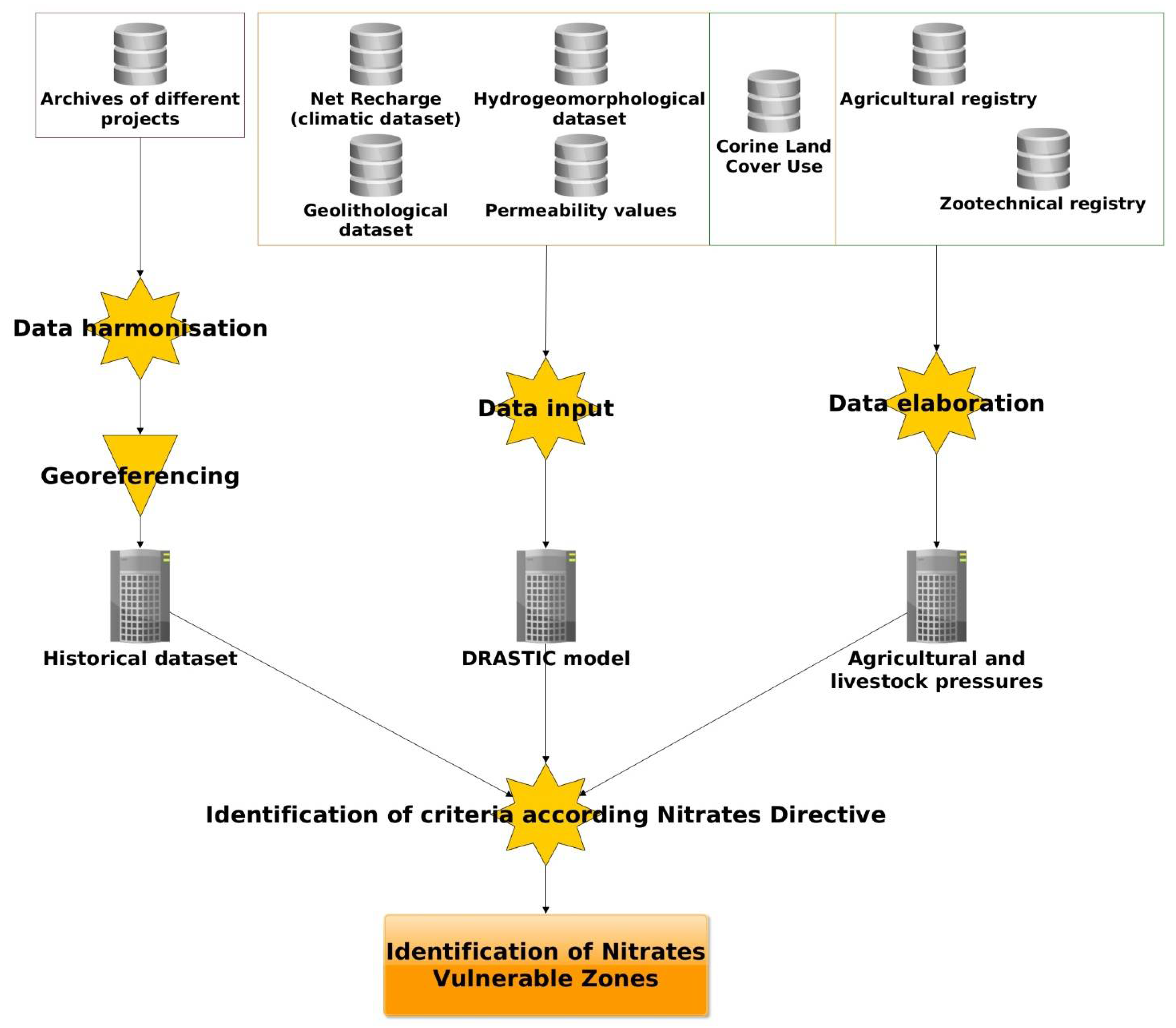

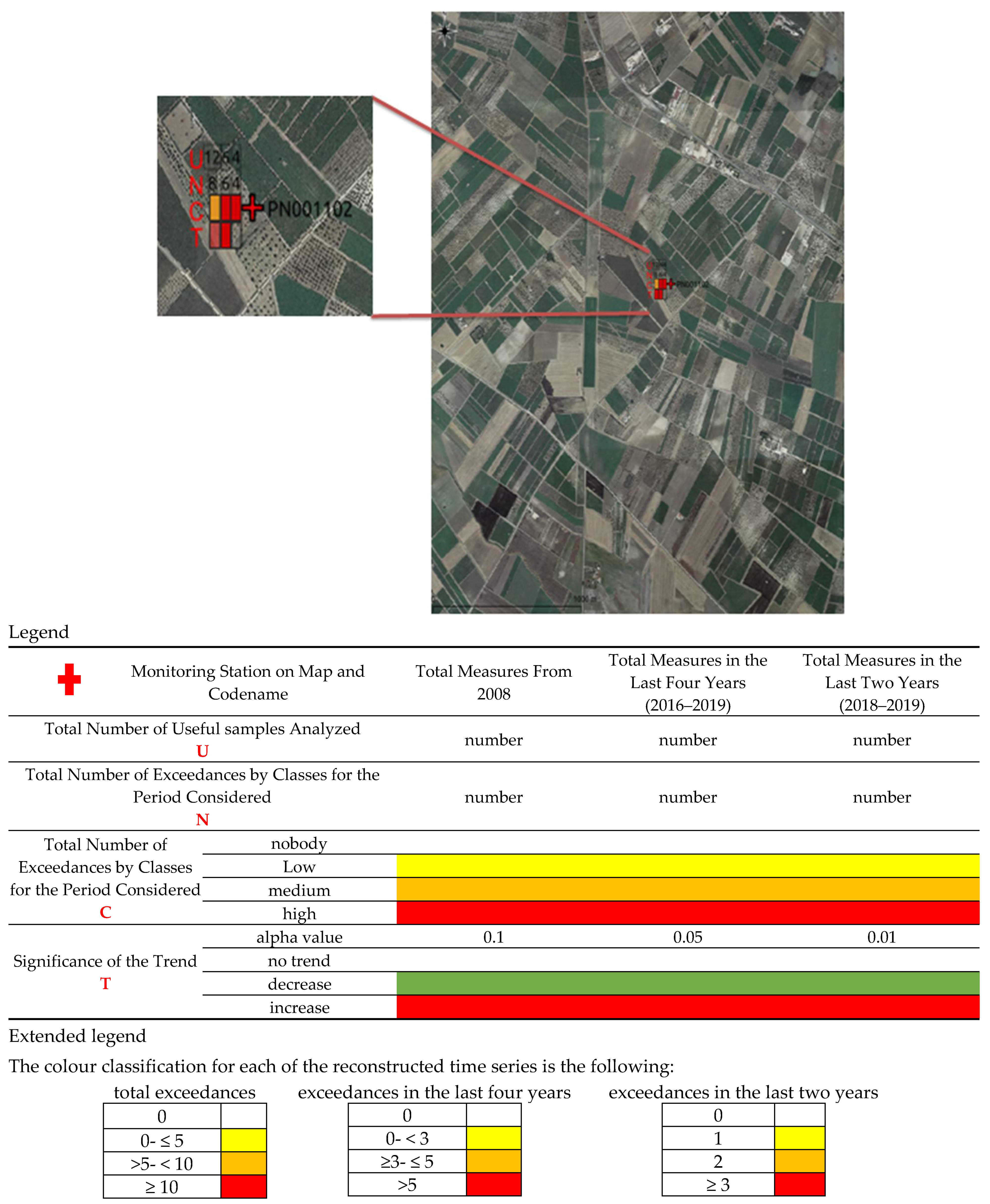
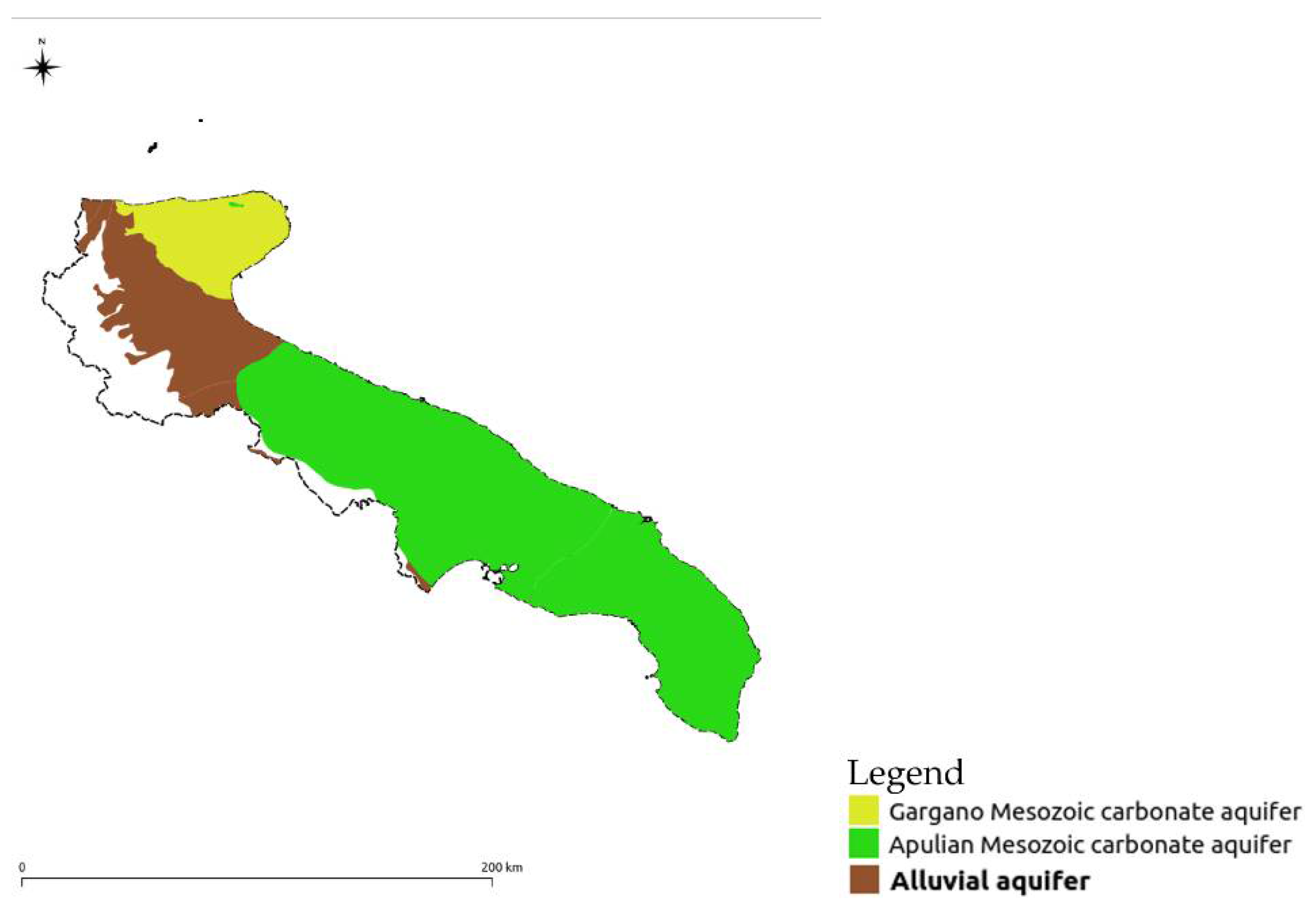

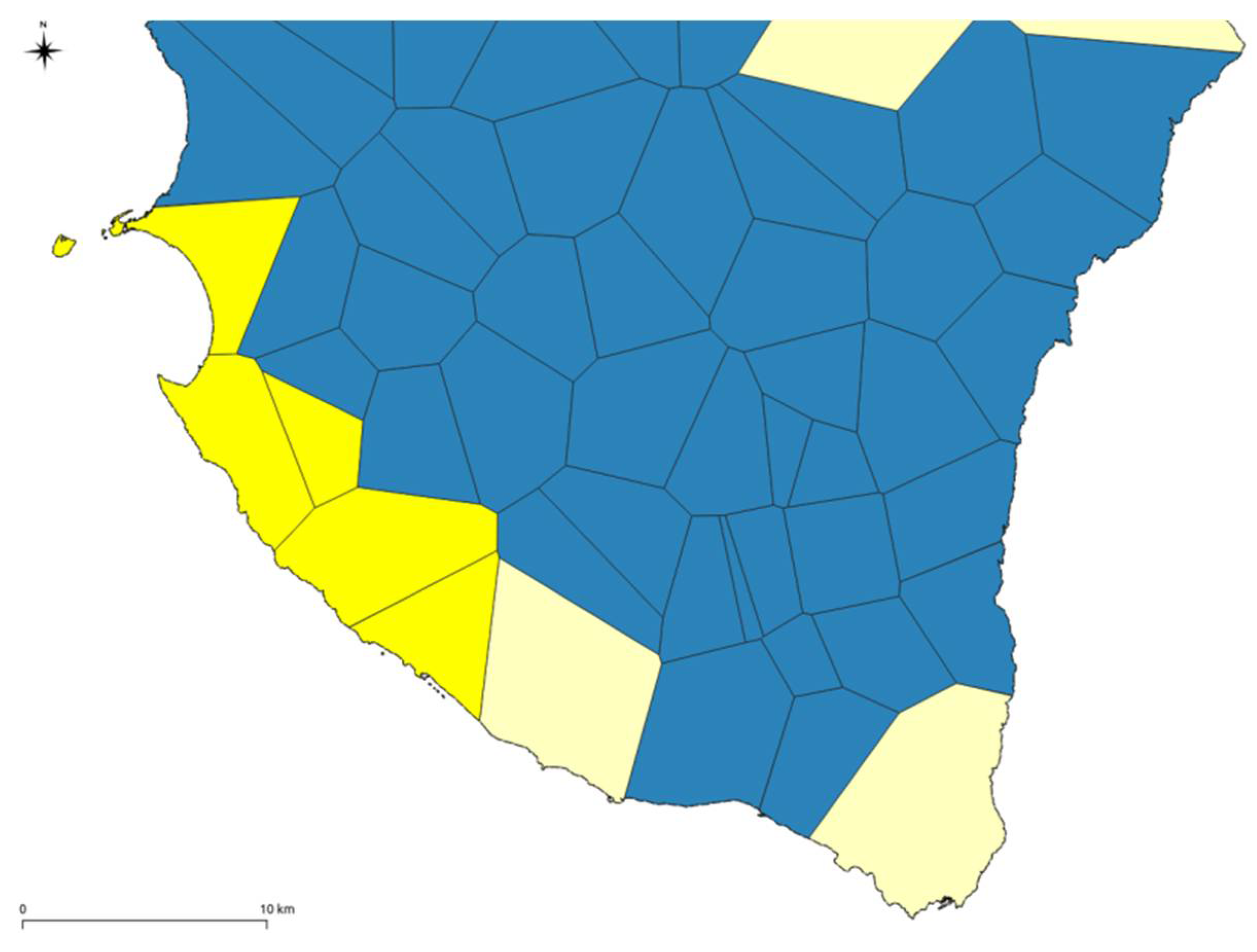
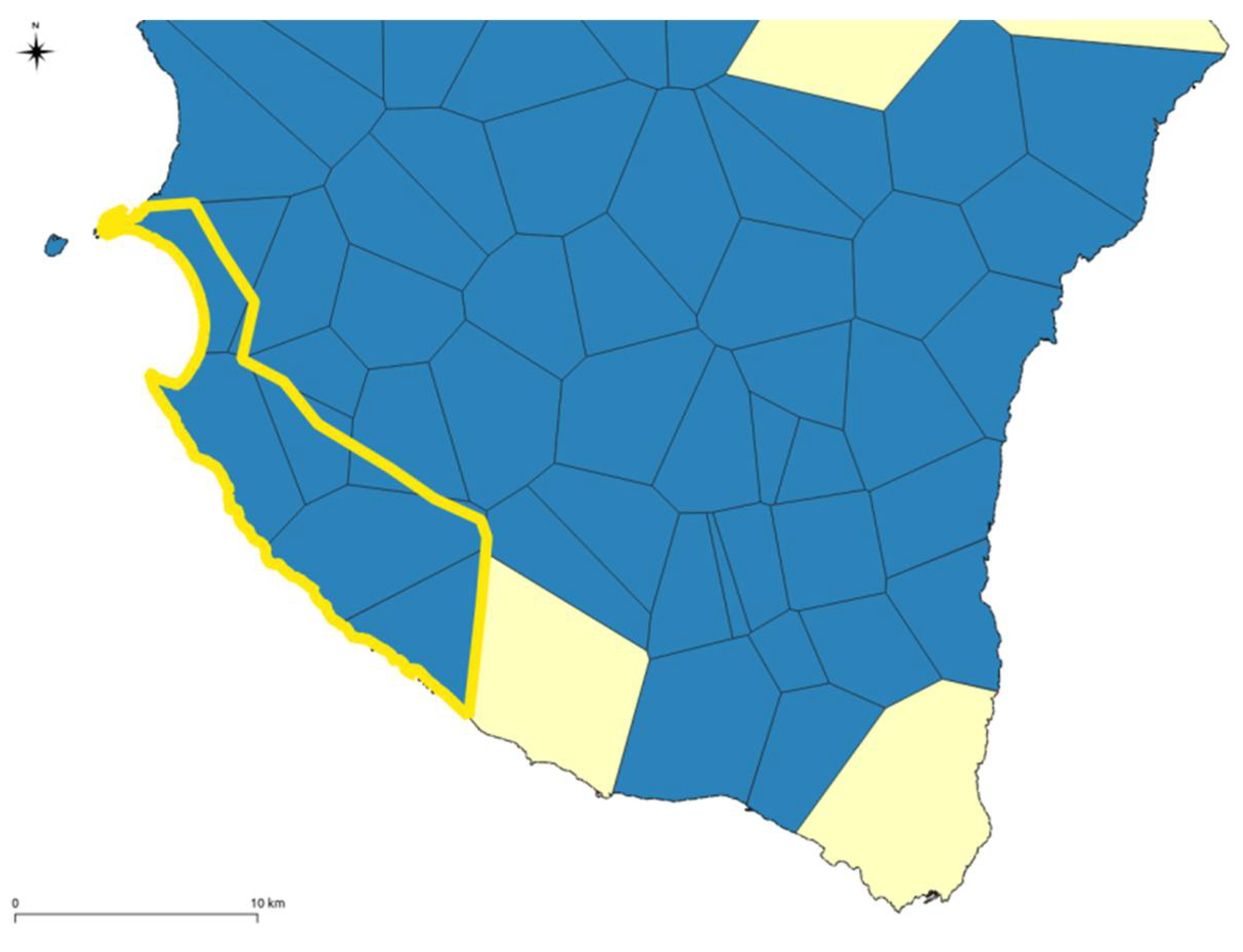
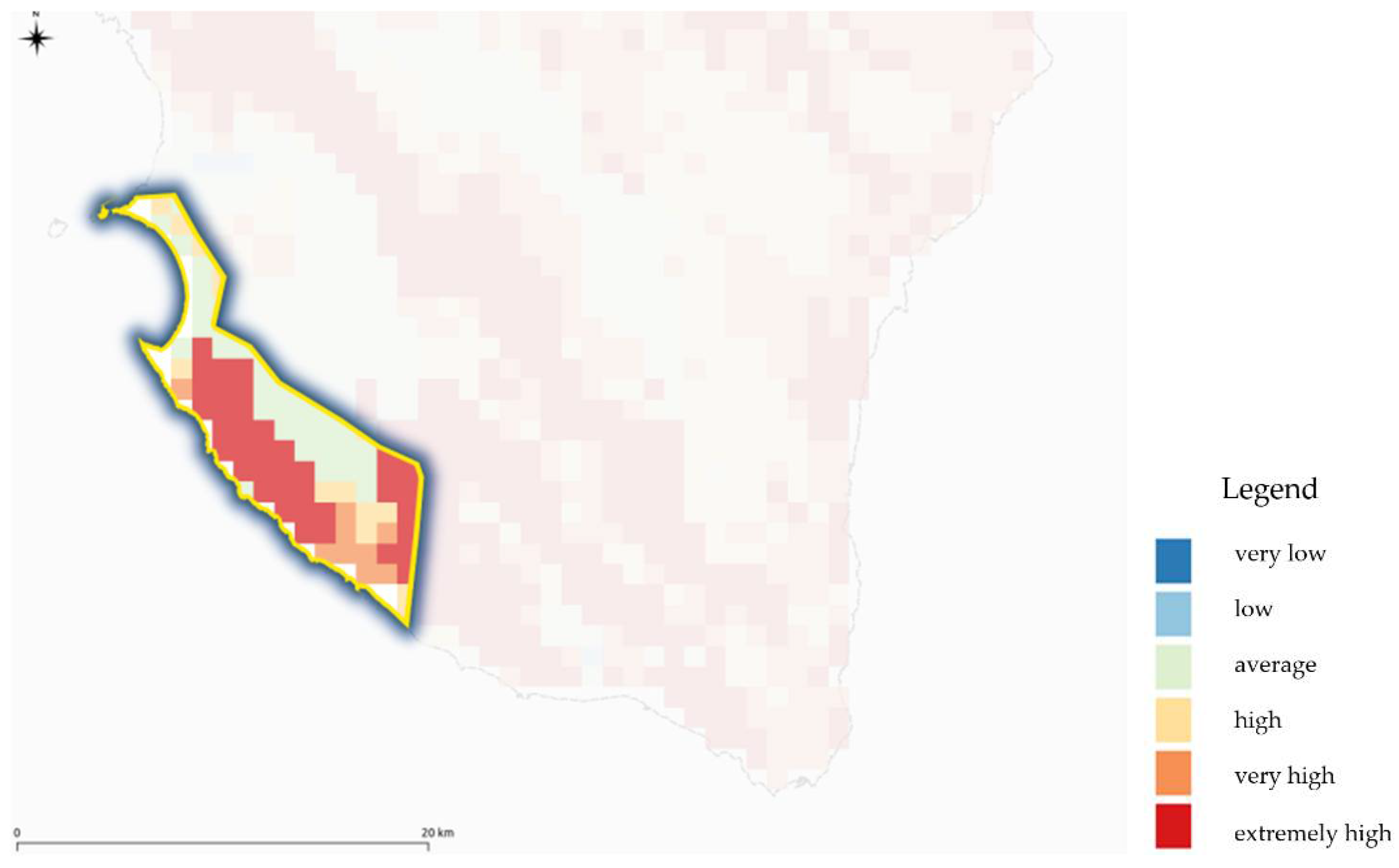
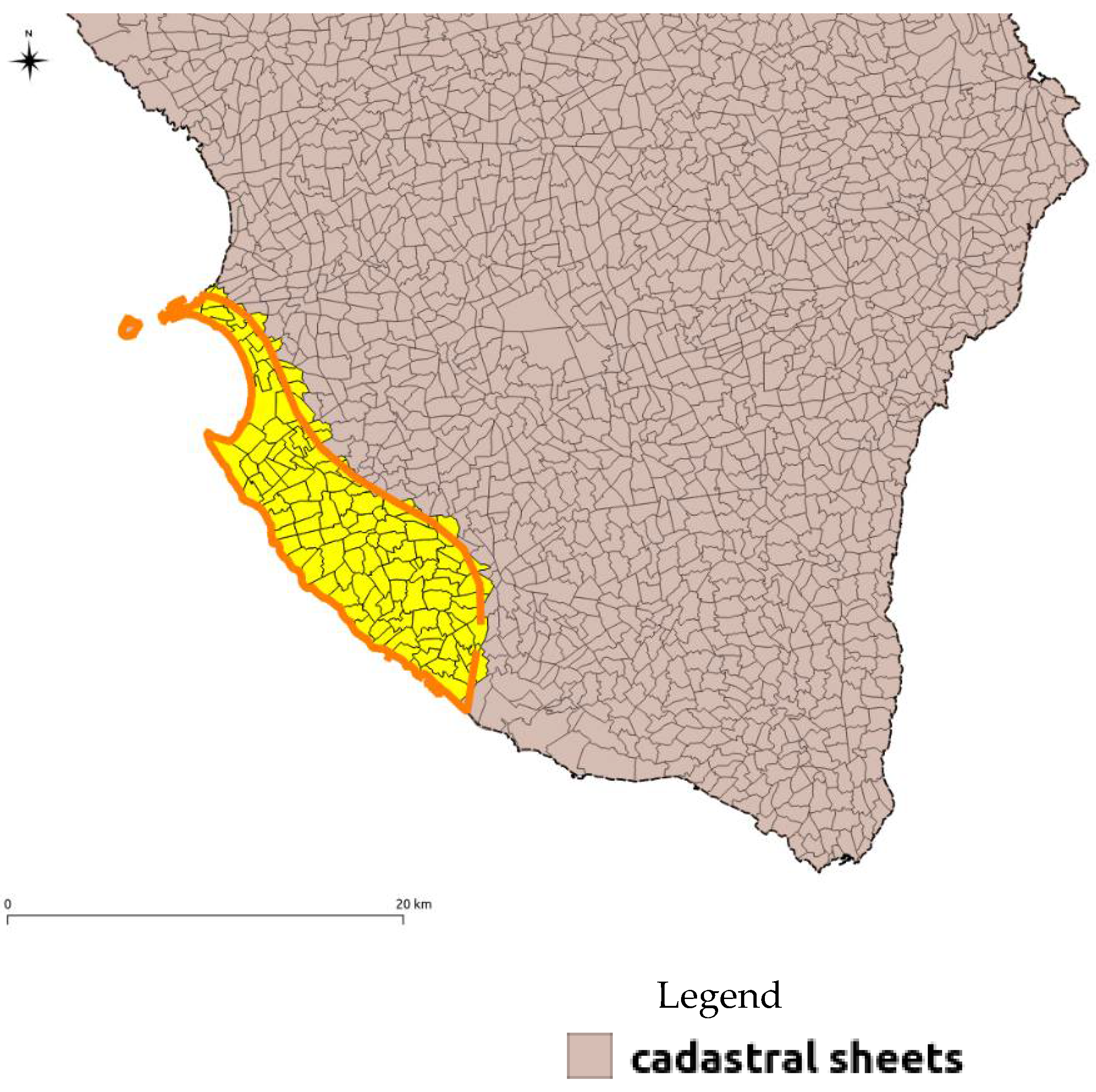

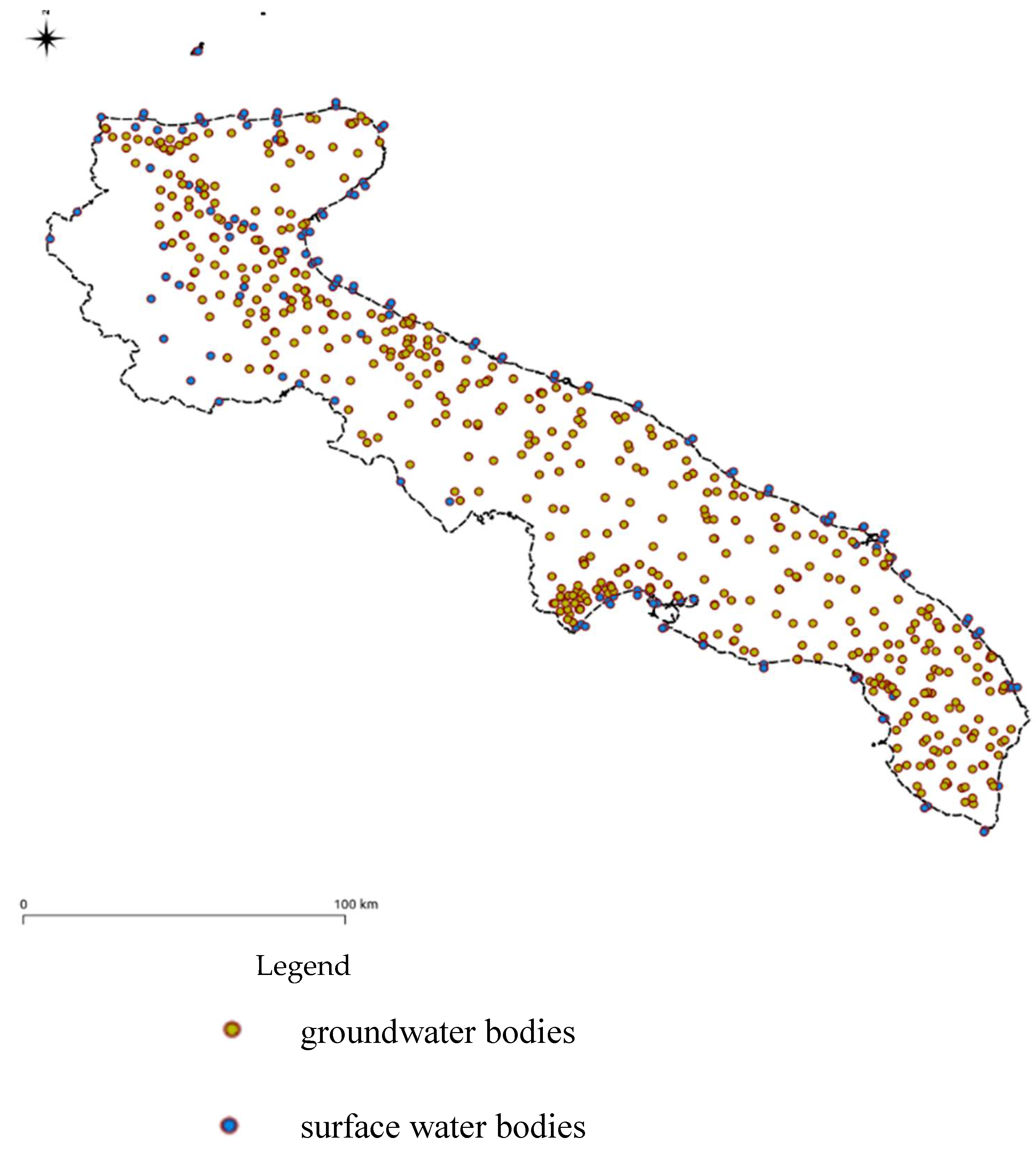
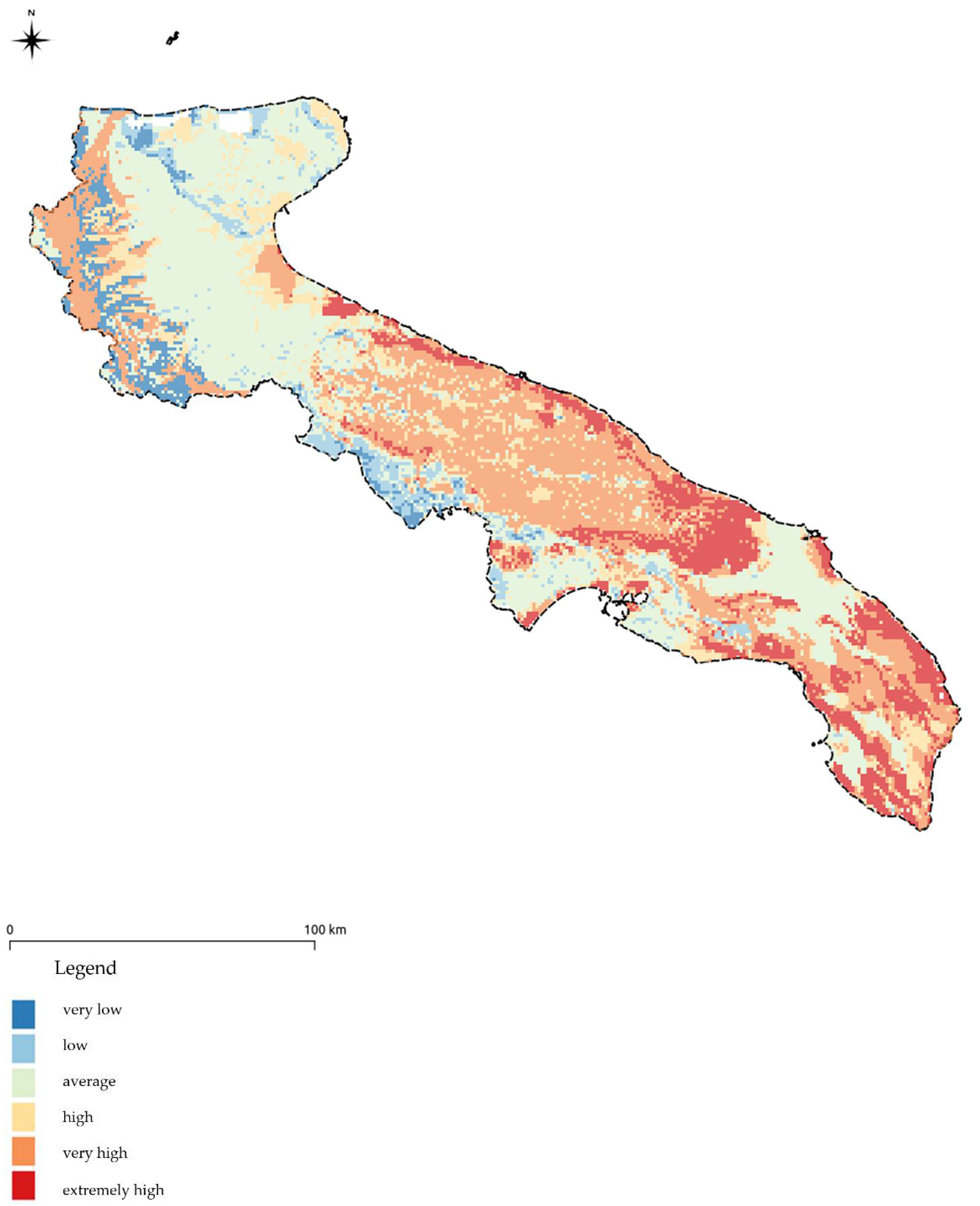

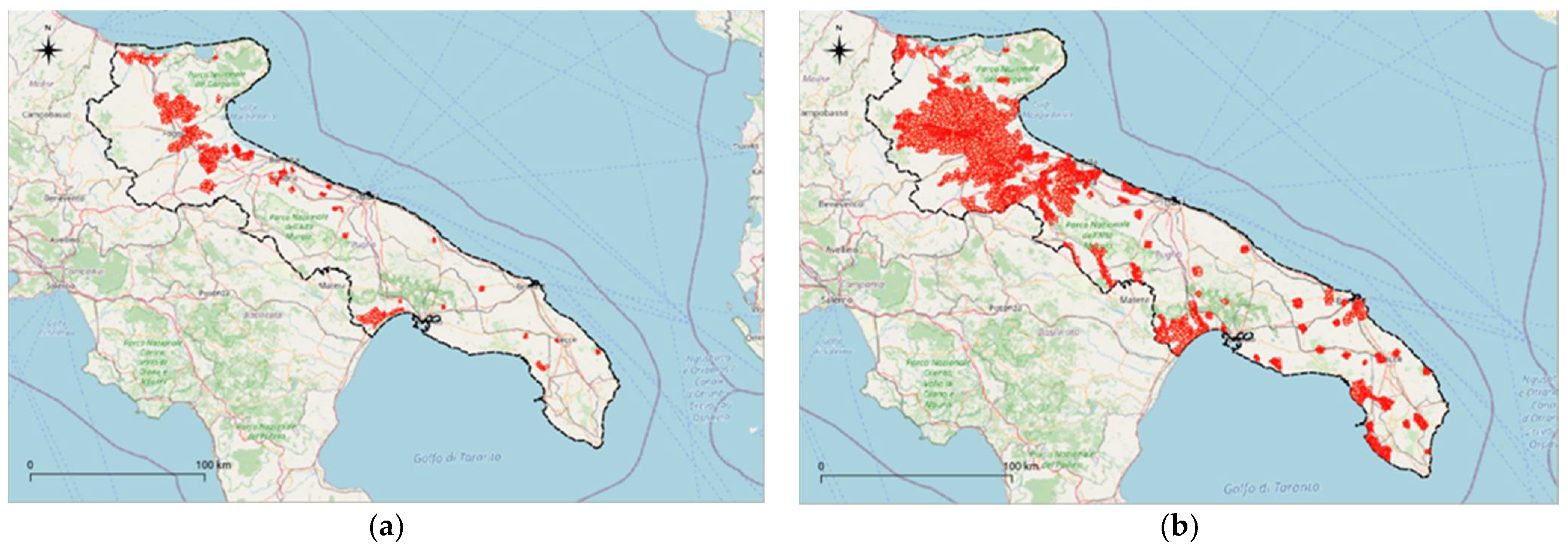
| Classification | Puglian Mesozoic Carbonate Aquifer | Puglian Mesozoic Carbonate Aquifer in the Gargano Area | Alluvial Aquifer of the Tavoliere |
|---|---|---|---|
| Very low | <75 | <90 | <70 |
| Low | 75–90 | 90–110 | 70–80 |
| Medium | 90–110 | 110–130 | 80–100 |
| High | 110–130 | >130 | 100–140 |
| Extremely high | >130 | >140 |
| Land Cover | Vegetable Crops | Nitrogen Uptake (Kg N/ha) |
|---|---|---|
| Permanent crops—Olive groves | Olive trees | 140 |
| Permanent crops—Vineyard | Wine grapes | 120 |
| Permanent crops—Vineyard | Table grapes | 150 |
| Permanent crops—Citrus groves | Orange, clementine, mandarins trees | 150 |
| Permanent Crops—Drupaceous | Apricot, peach, plum trees | 150 |
| Permanent crops—Drupaceous | Cherry, almond trees | 100 |
| Arable land—Cereals | Wheat, barley, oats, rye, soft wheat | 100 |
| Arable land—Fodder | Grassland (meadows) | 60 |
| Arable land—Fodder | Grassland (pasturage) | 40 |
| Arable land | Potato | 120 |
| Arable land | Tomato | 120 |
| Arable land | Artichoke | 120 |
| Arable land | Beetroot | 100 |
| Arable land | Umbelliferae family | 140 |
| Arable land | Brassicaceae family | 120 |
| Arable land | Salad | 140 |
| Arable land | Cucurbitaceae family | 180 |
| Arable land | Other horticultural species * | 145 |
| Category | Livestock Unit (LU) |
|---|---|
| Bulls, cows, and other bovine animals over two years, equine animals over six months | 1.0 |
| Bovine animals from six months to two years | 0.6 |
| Bovine animals below six months | 0.4 |
| Sheep | 0.15 |
| Goats | 0.15 |
| Breeding sows > 50 Kg | 0.5 |
| Other pigs | 0.3 |
| Laying hens | 0.014 |
| Other poultry | 0.003 |
| Biological Index | ||||||
|---|---|---|---|---|---|---|
| Bad | Rare | Enough | Good | High | ||
| Chemical/physical index | bad | E1 | E1 | E1 | E3 | E3 |
| rare | E1 | E1 | E1 | E3 | E3 | |
| enough | E1 | E1 | E2 | E3 | E3 | |
| good | E3 | E3 | E3 | N | N | |
| high | E3 | E3 | E3 | N | N | |
| Nitrate Concentration Values in mg/L (Average of the Last Four Years 2016–2019) | Number of Monitoring Stations |
|---|---|
| 0 < NO3 < 25 | 125 |
| 25 ≤ NO3 < 40 | 59 |
| 40 ≤ NO3 < 50 | 28 |
| NO3 ≥ 50 | 71 |
| Significative Trend (Alpha 0.05 over the Entire Time Series) | Number of Monitoring Points |
|---|---|
| decrease | 10 |
| stable | 148 |
| increase | 25 |
| not calculable (<8 values) | 100 |
| Province | Previous NVZs Extension (ha) (2012–2015) | Updated NVZs Extension (ha) (2021) | Impact on the Total Area (%) | Variation (%) |
|---|---|---|---|---|
| BARI | 3535 | 25,653 | 6.7 | +5.8 |
| BAT | 8290 | 54,851 | 35.9 | +30.5 |
| BRINDISI | 738 | 18,565 | 10.1 | +9.7 |
| FOGGIA | 75,707 | 280,338 | 40.3 | +29.4 |
| LECCE | 3578 | 35,374 | 12.8 | +11.5 |
| TARANTO | 12,207 | 38,124 | 15.7 | +10.7 |
| PUGLIA REGION | 104,055 | 452,905 | 20.2 | +16.3 |
Publisher’s Note: MDPI stays neutral with regard to jurisdictional claims in published maps and institutional affiliations. |
© 2021 by the authors. Licensee MDPI, Basel, Switzerland. This article is an open access article distributed under the terms and conditions of the Creative Commons Attribution (CC BY) license (https://creativecommons.org/licenses/by/4.0/).
Share and Cite
Massarelli, C.; Losacco, D.; Tumolo, M.; Campanale, C.; Uricchio, V.F. Protection of Water Resources from Agriculture Pollution: An Integrated Methodological Approach for the Nitrates Directive 91–676-EEC Implementation. Int. J. Environ. Res. Public Health 2021, 18, 13323. https://doi.org/10.3390/ijerph182413323
Massarelli C, Losacco D, Tumolo M, Campanale C, Uricchio VF. Protection of Water Resources from Agriculture Pollution: An Integrated Methodological Approach for the Nitrates Directive 91–676-EEC Implementation. International Journal of Environmental Research and Public Health. 2021; 18(24):13323. https://doi.org/10.3390/ijerph182413323
Chicago/Turabian StyleMassarelli, Carmine, Daniela Losacco, Marina Tumolo, Claudia Campanale, and Vito Felice Uricchio. 2021. "Protection of Water Resources from Agriculture Pollution: An Integrated Methodological Approach for the Nitrates Directive 91–676-EEC Implementation" International Journal of Environmental Research and Public Health 18, no. 24: 13323. https://doi.org/10.3390/ijerph182413323
APA StyleMassarelli, C., Losacco, D., Tumolo, M., Campanale, C., & Uricchio, V. F. (2021). Protection of Water Resources from Agriculture Pollution: An Integrated Methodological Approach for the Nitrates Directive 91–676-EEC Implementation. International Journal of Environmental Research and Public Health, 18(24), 13323. https://doi.org/10.3390/ijerph182413323










